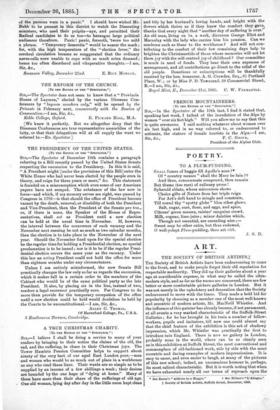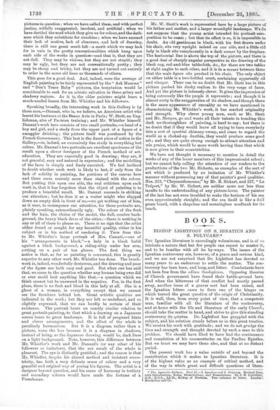ART.
THE SOCIETY OF BRITISH ARTISTS.:
Tim Society of British Artists have been endeavouring to come to the front, and to make people forget their old reputation for respectable mediocrity. They did up their galleries about a year ago at considerable expense, in what may be called the ultra- modern style, and as far as the rooms are concerned, there are few better or more comfortable picture galleries in London. But it was not merely in the upholstery and decoration that the Society endeavoured to move with the times. They made a bold bid for popularity by choosing as a member one of the most well-known and eccentric of modern artiste, Mr. MacNeill Whistler. And the influence of this painter has already become, if not paramount, at all events a very marked characteristic of the Suffolk-Street Galleries ; for be has brought in his train a number of fellow. workers, pupils and imitators, till now one could almost say that the chief feature of the exhibition is this art of shadowy impression, which Mr. Whistler was practically the first to introduce into England. There is now no gallery in London, probably none in the world, where can be so clearly seen as in this exhibition at Suffolk Street, the most conventional and commonplace of old-fashioned work, side by side with the most eccentric and daring examples of modern impressionism. It is easy to sneer, and even easier to laugh, at many of the pictures of this new school ; indeed, an unconscious humour is, perhaps, its most salient characteristic. But it is worth noting that when we have exhausted nearly all our terms of reproach upon the • see Burns's "Address to a Haggis." t See Hilton's "L'Allegeo:' T Society of British Artiste, Suffolk Street, December, 1885. pictures in question ; when we have called them, and with perfect justice, wilfully exaggerated, insolent, and artificial ; when we have derided the mud which they give us for colour, and the dark- ness which they substitute for sunshine ; when we have scorned their lack of motive, lack of clearness, and lack of drawing, there is still one great merit left—a merit which we may look for in vain in the pretty conventionalities which hang upon each side of the works in question—and that is, that they are not dull. They may be vicious, but they are not stupid ; they may be ugly,. but they are not conventionally pretty ; they may be cheap and tricky, but they are not turned out entirely to order in the same old lines as thousands of others.
This goes for a good deal. And, indeed, were the average of English painting to be fairly represented by the "Ask Mamma" and "Don't Tease Baby" pictures, the temptation would be considerable to seek for an artistic salvation in these grimy and shadowy regions. As it is, the older painters might learn a much-needed lesson from Mr. Whistler and his followers.
Speaking broadly, the interesting work in this Gallery is by three men,—Dannat, who is, we believe, an American artist who learnt his business at the Beaux Arts in Paris; W. Stott, an Eng- lishman, also of Parisian training ; and Mr. Whistler himself. Dannat's work here consists of two small portraits,—a head of a boy and girl, and a study from the upper part of a figure of a smuggler drinking ; the picture itself was purchased by the French Government. This last is the finest piece of action in the Gallery,—is, indeed, an excessively fine study in everything but colour. Mr. Dannat's two portraits are excellent specimens of the result upon a clever foreigner of the French method of art- education. They are especially good in drawing ; they are, if not graceful, easy and natural in expression ; and the modelling of the faces is simply and finely executed. We feel inclined to doubt whether such work is likely to last, if only from the lack of solidity in painting, for portions of the canvas here and there seem scarcely more than stained with the colour. But putting this upon one side, the real criticism upon such work is, that it has forgotten that the object of painting is to produce a beautiful result. Mr. Dannat succeeds in striking our attention ; but he does it as a waiter might who slapped down an empty dish in front of us,—we get nothing out of him, as it were, to recompense our attention, for these portraits are, plainly speaking, extraordinarily ugly. The colour of the flesh and the hair, the choice of the model, the dull, sombre back- ground, the heavy black dress of the sitter,—there is nothing in any or all of these to please us. There is no sign that the artist either found or sought for any beautiful quality, either in his subject or in his method of rendering it. Turn from this to Mr. Whistler's large portrait of Mrs. Cassati,—one of his "arrangements in black,"—a lady in a black habit against a black background, a riding-whip under her arm, putting on a pair of tan gloves. The first thing we notice is that, as far as painting is concerned, this is greatly superior to any other work Mr. Whistler has done. The brush- work is, indeed, wonderfully dexterous, and the drawing and pose of the figure are both easy and good. But when one has said that, we come to the question whether any human being ever did or ever could look anything like that,—a question which we think cannot but be answered in the negative. For, in the first place, there is no flesh and blood in this lady at all. She is a ghost of a woman, in everything except that we cannot see the furniture behind her. Great artistic qualities are indicated in the work ; but they are left so undefined, and so slightly expressed, that we can hardly be certain of their existence. The portrait bears an exactly similar relation to great portrait-painting, to that which a drawing on a Japanese screen bears to great landscape. It is full of pregnant hints and clever arrangements, and the effect of the whole is peculiarly harmonious. But it is a diagram rather than a picture, none the less because it is a diagram in shadows, instead of being, as the Japanese drawing would be, dark lines on a light background. Note, however, this difference between Mr. Whistler's work and Mr. Dannat's (or any other of his followers or imitators), that the net result of the whole is pleasant. The eye is distinctly gratified ; and the reason is that Mr. Whistler, despite his absurd method and insistent eccen- tricity, has both a very delicate sense of colour and a very graceful and original way of posing his figures. The artist is a designer beyond question, and his sense of harmony in tertiary and secondary colours would have made the fortune of a Frenchman. Mr. W. Stott's work is represented here by a large picture of his father and mother, and a larger moonlight landscape. We do not suppose that the young artist intended his portrait com- position to be comic ; but that its effect is so, it is impossible to doubt. An old gentleman in black, with his feet drawn under his chair, sits very upright indeed on one side, and a little old lady in black sits complacently in a dark corner by the fireplace. The horizontal line is above the top of the picture, and there is a good deal of sharply angular perspective in the drawing of the black rug, red.and-blue tablecloth, ckc., for there are two tables at right angles to each other, and it is in a corner between them that the male figure sits perched in his chair. The only object on either table is a two-bottled cruet, containing apparently oil and vinegar. There can be no doubt that Mr. Stott has in this picture pushed his dusky realism to the very verge of farce. And yet the picture is intensely clever. It gives the impression of being extremely like the people it represents ; and though it is almost sooty in the exaggeration of its shadow, and though there is the same appearance of unreality as we have mentioned in oharacterising Mr. Whistler's work, it has marked originality and strength. Why clever young men, such as Mr. Stott and Mr. Menpes, go and waste all their talents in treading this dark no-thoroughfare of painting, is hard to say ; but there is no doubt that if they would leave off trying to turn everybody into a sort of spectral chimney-sweep, and cease to regard the world as a choked-up dustbin, they would produce some good art; and they are quite strong enough to attract attention and win praise, which would be more worth having than that which is now given to their eccentricities.
We have not thought it necessary to mention in detail the works of any of the lesser members of this impressionist school ; but we cannot help calling the attention of our readers to the productions of the two Mr. Sickerts, as examples of the sort of art which is produced by an imitation of Mr. Whistler's manner without possessing any of that painter's good qualities. Nos. 213, "Chrysanthemums," by Mr. B. Sickert, and 227, "Le Treport," by Mr. W. Sickert, are neither more nor less than insults to the understanding of any picture-lover. The painter of the last has not even troubled to make the horizon of his sea even approximately straight; and the sea itself is like a dull green board, with a shapeless and meaningless mndbank for its. beach.



































 Previous page
Previous page